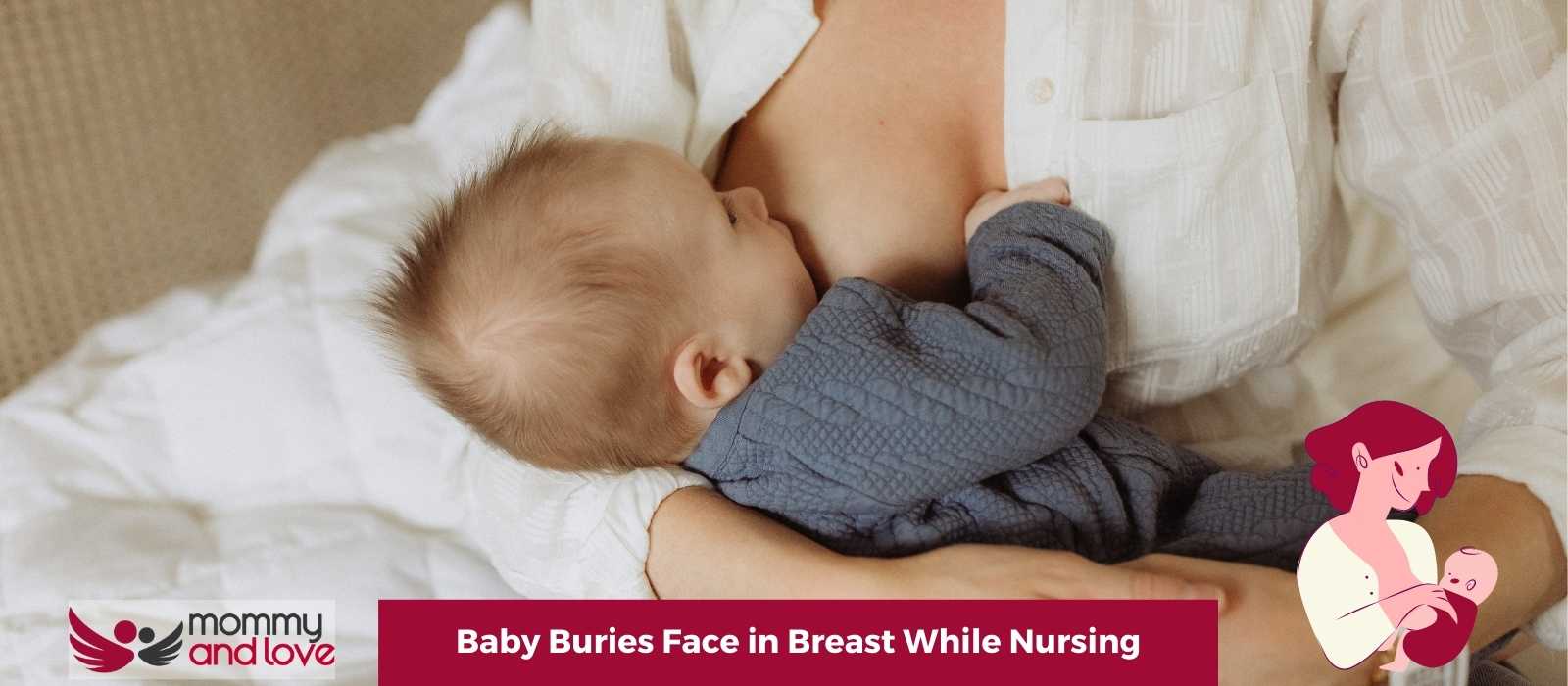Baby buries face in breast while nursing? Let’s look at why your little one does this, and what you should do.
Nursing is a special time for mother and newborn baby, and recent research shows that it may be even more beneficial than previously thought. Scientists and doctor have found that when baby bury their faces into their mothers’ breasts while nursing, they are actually stimulating the production of oxytocin in both the mother and the baby.
Babies are amazing, and they can do some pretty incredible things—like nurse! But sometimes the way a baby nurses can be a little alarming.
Why Do Babies Bury Their Faces in Breasts?

It’s a common misconception that babies nurse only to feed. In fact, frequent nursing is not only for the purpose of getting more milk but also to maintain closeness and warmth with their mother.
The baby will often suckle (nurse) on one breast until it becomes full and then continue to nurse from the other breast.
The reason for this behavior is that most babies like to suck on the breast – aside from getting enough milk supply from the mother’s breast, it provides a sense of comfort and security. The sucking motion also helps release natural hormones from your baby’s brain, helping them feel calm and develop their sensory seeking behaviors.
Oxytocin is a hormone that is produced in both the mother and baby during nursing. It is responsible for many of the benefits of nursing, including the strengthening of the mother-baby bond. This contributes to baby’s amazing development track.
Why do babies like to bury their faces for comfort?
It’s a question plenty of parents of newborns has asked: why do babies like to bury their faces in a parent’s chest?
For some babies, it’s actually a way to get more milk. When they’re nuzzled close to you, they can easily find their way to the breast or nipple, and they can promote the flow of milk by sucking on your chest. It’s an instinct the baby is born with, and when they snuggle up close, they’re not only feeling comforted by your skin and presence—they’re also getting fed.
It’s common to see a baby burrow its face, a mother’s breast and heartbeat are familiar and comforting, and if you’re breastfeeding, this is a great way for them to bond with you.
The behavior itself helps trigger the fast flow of milk production by stimulating certain hormones in the breast. Mother can further help by performing breast compressions.
According to a leading pediatrician, “As long as the mouth and nose of the child are free and open for breathing, the baby cannot suffocate on the breast.” Your child will not have any trouble breathing and is able to get enough and not too much milk this way, there’s no reason to worry!
What is Rooting?
Most of us have met a newborn baby. If you have, chances are good that you’ve seen the baby “root” when it was touched on the cheek. When the baby’s cheek or lip is touched, they will automatically turn their head and make sucking motions which will help them to find the breast.
From the moment your baby is born, the rooting reflex is a normal sign that your baby needs to eat. As parents, the first few weeks after birth are tough; babies don’t have much of an immune system and can be really unhappy about it.
That means their bodies need all types of nutrients available in milk (including protein) throughout their baby life. The rooting reflex helps to ensure successful breastfeeding for baby growth.
Our post on everything you need to know about breastfeeding is a great way to help you get started!
Are they Seeking Comfort?
It’s part of the vital milk-finding strategy they’re born with. So, if your baby is always crying when you set her down, it might mean she wants to be held close to your body and feel the touch of your skin on her cheek.
If you’re wanting some time away from the constant holding but still want to make your baby happy, try putting her in a wrap carrier on the bed or sling where she can feel close to you.
What Does a Good Latch Feel Like?

Have you ever noticed how your baby’s cheeks look rounded and soft while they feed on the breast? They seem so calm, it gives mother such peace of mind.
A good latch feels like your baby is sucking on your breast, with their lips forming a complete seal around the nipple and areola. You should be able to feel them suck and swallow. When they release the breast, you should have no pain and minimal leaking.
If the baby’s mouth is wide open at the corner of her lips, this can be a good sign. Ones that are closed or bit by themselves aren’t usually able to form any kind of expression so it might take some time before they show anything but pure satisfaction from eating!
The Baby is Gulping, Choking, and Always Seems Fussy at the Breast
The baby is always fussy when it’s time to breastfeed. It seems like he cannot get enough of the milk from your breasts and will not be satisfied. Does this sound familiar?
When mom has an oversupply of milk, her baby will often show signs such as restlessness at the breast, gulping, and coughing. Other common behaviors include choking or gagging when feeding time comes around again because they’re so busy trying to manage the milk flow.
Another possible explanation is a baby growth spurt, this is a period of rapid growth in the infant that can make 8them go through a short stage of being fussy or wanting to eat constantly.
If your baby is persistently making noises that concern you, you can read more about the sounds babies make while nursing
Can a Baby Suffocate While Breastfeeding?

The death of an infant due to accidental suffocation is often overlooked and still attributed in some cases to Sudden Infant Death Syndrome (SIDS).
The accidental suffocation of an infant has been reported in the medical literature as being rarely caused by breast overlaying during breastfeeding.
It’s important to remember, however, that the case of a mother falling asleep in an unsafe sleeping situation carries risks that are extremely different to the risk that might apply with everyday nursing, or nursing while safely co-sleeping.
When properly positioned, the baby’s mouth covers most of the areola and nipple, and the baby’s tongue presses against the bottom of the breast to squeeze milk out. This is called a “deep latch.”
A deep latch is good when the baby’s mouth is open wide and their top lip is curved up over their bottom lip. Their tongue should be down in the middle of their mouth and their chin should be pressed into their chest. You will notice though that baby’s nose is clear, allowing him access to air supply.
The baby’s sucking rhythm and strength can sometimes override the mother’s milk ejection reflex, causing her milk to flow more slowly or not at all. This can be frustrating for both mom and baby.
If you are worried that your baby has spent too much time nursing and isn’t able to catch its breath, gently stroke its back until it raises its head from your breast.
If you’re worried about whether or not your baby is getting enough air, you can move your finger around in front of your baby’s mouth during feeding time to make sure that air is available. You shouldn’t have to do this, but if you’re concerned, it can help put your mind at ease.
Sudden Infant Death Syndrome
Sudden infant death syndrome (SIDS) is the sudden and unexplained death of a baby less than one-year-old. SIDS is the leading cause of death in babies from 1 to 12 months old. Most deaths occur while the baby is asleep.
SIDS is not to be confused with suffocation or strangulation, which are factors that can cause infant death and are usually the result of parental or caregiver neglect. It is often caused by other factors such as a weak immune system or respiratory infection.
To prevent SIDS, health care professionals recommend that parents put their babies to sleep on their backs, avoid devices such as pillows or crib bumpers, and place baby in a smoke-free environment. With the right precautions, SIDS is not to be alarmed by parents.
How Do You Know When Your Newborn Baby Doesn’t Want to Breastfeed Anymore?
Your baby will know when he or she doesn’t want to nurse anymore—you’ll know it too because he or she will pull away from your breast and might fuss at being put back on the breast for more nursing.
When your baby doesn’t want to breastfeed anymore, they will not be happy. They may cry before, during, and after feeding, refuse the breast or nipple by turning their head or pushing your hand away. Sometimes they might also do things like pulling off the breast instead of suckling. Check out our guide on why babies squirm and grunt while breastfeeding
Breastfeeding Is A Beautiful Thing
Breastfeeding is a natural process that most mothers and babies enjoy. It provides comfort and security for the baby, as well as important nutrients for their growth and development.
However, there are times when breastfeeding can be difficult, such as when the baby doesn’t want to breastfeed anymore or has difficulty latching on properly.
Always consult your pediatrician, doctor, or lactation consultant before making any changes to the way you care for your newborns or infants.
Breastfeeding isn’t always easy or comfortable, especially during those first few weeks when your baby is learning the best ways to breastfeed. But don’t give up too soon! Keeping a good breastfeeding relationship is vital for both you and your child.

This article was written by Sandra Baker – full time writer and the mother of four amazing kids (including twins!)
She’s also a breastfeeding counselor and has spent years helping new parents learn how to care for their children. When she’s not writing or caring for her children, Sandra likes to spend time reading and taking walks with her husband.




